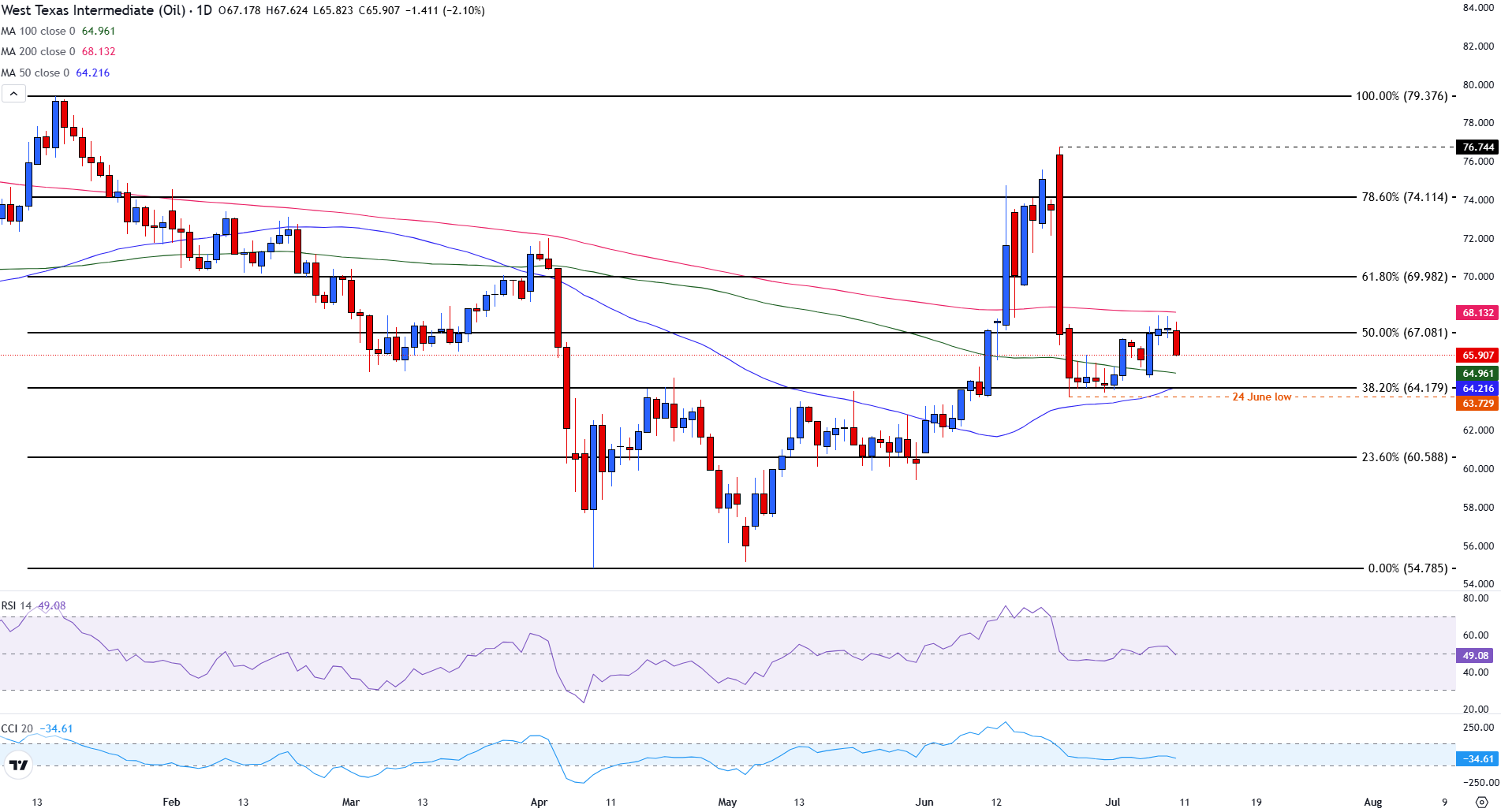- WTI crude oil as reports confirm a robust supply.
- Attacks in the Red Sea and the increase in geopolitical risks could continue to influence prices if concerns increase.
- Trump’s tariff threats weigh on feeling, reducing oil demand expectations.
The West Texas Intermediate (WTI) crude oil is quoting downward on Thursday, falling below the $ 67.00 brand while the markets react to renewed concerns about the supply and demand expectations in decline.
At the time of writing, the WTI quote around $ 66,80 per barrel with losses close to 2% intradic.
The losses have accelerated after the US president, Donald Trump, confirmed a 50% tariff on copper imports, effective as of August 1. He has also threatened 50% tariffs on all goods imported to the US from Brazil.
The renewed commercial rhetoric has revived concerns about global growth and demand for raw materials, weighing even more about the feeling of risk.
Adding to market restlessness, the latest report of the US Energy Information Administration (EIA), published on Wednesday, delivered an unexpected blow. Instead of the anticipated reduction of 2 million barrels, US oil stocks increased by 7.07 million barrels last week, reinforcing concerns about the weakening of short -term consumption.
Geopolitical tensions remain raised after a series of attacks in the Red Sea claimed by the hutis rebels of Yemen. These attacks have generated concerns about the safety of shipping routes in the region, which could interrupt the flow of crude oil. On Sunday, the Magic Seas, a Greek ownership bulk vessel, was beaten and sank after the crew evacuated.
Violence intensified on Monday when Eternity C, a Liberian flag ship and operated by Greeks, was attacked by hutis fast drones and boats. Several crew members were reported as dead or missing, and the ship sank at the beginning of Wednesday. These incidents could lead to an increase in insurance costs for maritime transport in the region, which could impact crude oil prices.
Although the global supply remains robust, particularly with OPEC+ confirming an increase in production of 548,000 barrels per day for August, continuous interruptions on shipping routes and the significant increase in freight insurance costs in the Red Sea could offer limited support to prices in the short term.
WTI Technical Analysis: US Crude Petroleum Daily Graph
WTI crude oil faces a renewed sales pressure near the level of $ 67.00, fighting to break up after recent profits.
The support is found in the single mobile average (SMA) of 100 days at $ 64.97, with an additional risk to the 50 -day SMA in $ 64.23 and the fibonacci setback of 38.2% of the fall from January to April at 64.18 $.
The minimum of June 24 at $ 63.73 marks an additional short -term pivot for downward scenarios.
The price action in the daily graph shows that the WTI decreases after testing the 50.0%recoil level, located at $ 67.08.
The immediate resistance is at this level. A sustained closure above this threshold could open the door to the 200 -day SMA at $ 68.14, followed by the 61.8% setback in $ 69.98.

The relative force index (RSI) is around 49, indicating a neutral momentum and a limited directional conviction at this stage.
The raw material channel index (CCI) is located in -35, suggesting a slightly low -term downstream feeling, but that the WTI is not yet in overall territory.
WTI oil – frequent questions
WTI oil is a type of crude oil that is sold in international markets. WTI are the acronym of West Texas Intermediate, one of the three main types that include the Brent and Dubai’s crude. The WTI is also known as “light” and “sweet” by its relatively low gravity and sulfur content, respectively. It is considered high quality oil that is easily refined. It is obtained in the United States and is distributed through the Cushing Center, considered “the crossing of the world.” It is a reference for the oil market and the price of WTI is frequently traded in the media.
Like all assets, supply and demand are the main factors that determine the price of WTI oil. As such, global growth can be a driver of the increase in demand and vice versa in the case of weak global growth. Political instability, wars and sanctions can alter the offer and have an impact on prices. OPEC decisions, a group of large oil -producing countries, is another key price factor. The value of the US dollar influences the price of WTI crude oil, since oil is mainly traded in US dollars, so a weaker dollar can make oil more affordable and vice versa.
Weekly reports on oil inventories published by the American Petroleum Institute (API) and the Energy Information Agency (EIA) influence the price of WTI oil. Changes in inventories reflect the fluctuation of supply and demand. If the data show a decrease in inventories, it can indicate an increase in demand, which would raise the price of oil. An increase in inventories may reflect an increase in supply, which makes prices lower. The API report is published every Tuesday and that of the EIA the next day. Their results are usually similar, with a 1% difference between them 75% of the time. EIA data is considered more reliable, since it is a government agency.
The OPEC (Organization of Petroleum Exporting Countries) is a group of 13 nations oil producing that collectively decide the production quotas of member countries in biannual meetings. Their decisions usually influence WTI oil prices. When OPEC decides to reduce fees, it can restrict the supply and raise oil prices. When OPEC increases production, the opposite effect occurs. The OPEC+ is an expanded group that includes another ten non -members of the OPEC, among which Russia stands out.
Source: Fx Street
I am Joshua Winder, a senior-level journalist and editor at World Stock Market. I specialize in covering news related to the stock market and economic trends. With more than 8 years of experience in this field, I have become an expert in financial reporting.







